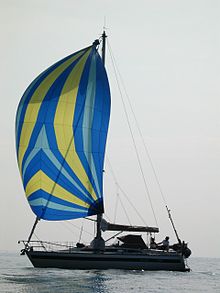spinnaker

The spinnaker [ ˈʃpɪnakɐ ] or Spi for short is a particularly large, bulbous foresail made of light cloth , which is used in front of the wind and on a space sheet course to enlarge the sail area.
Origin of the designation
According to Erhard Jung, the name comes from the English yacht "SPHINX", which used such a sail for the first time in 1866. The name was then corrupted and linguistically modified. Wolfram Claviez, on the other hand, explains the etymology from the English word pair "spin-maker" in the sense of "whiz away, fast ride, fast ride".
Use and operation
What is special about the spinnaker is that, in contrast to scrap sails, it is driven with completely free leeches on two sheets . The leeward sheet is referred to as the spike sheet , the windward sheet as the stern hauler (see also: windward and leeward ).
The neck of the spinnaker, its windward side, is expanded with the help of a spinnaker tree and supported on the mast. The angle of the spinnaker pole to the mast can be changed with the eighth hauler. The spinnaker pole should always be at right angles to the apparent wind . However, the forestay limits the angle. From an angle of 70 degrees to the wind, a genoa generates more propulsion.
cut
The sail is cut three-dimensionally in a conspicuously balloon-like shape. The formation can be achieved in various ways. In the past, the symmetrical structure of the sail was common to all cuts . Well-known manufacturers of sails now also deliver asymmetrical sails for certain applications. You can often see spinnakers with elaborately designed motifs. The cut and the sewing of the lengths of fabric determine the effort for the production, but also the strength of the corresponding spinnaker. Typical shapes are the head-radial cut (simple), the tri-radial cut (better) and the tri-star cut (the most complex).
Seat the spinnaker
The easiest way to set the spinnaker is leeward of the foresail. On courses with clear wind, the spinnaker is attached to the outside of the pulpit and quickly set (pulled up), while the foresail remains stationary and the spinnaker does not get any wind. Only then is the headsail recovered and the spinnaker, which is now filling, trimmed.
A variant for strong winds is to bundle the spinnaker with rubber bands at a distance of about one meter into a roll and set it that way. Then the rubber bands are brought to break with a jerk on the stern hauler and spinnaker sheet.
Some sailing boats are equipped with a spinnaker trumpet . This device in the bow makes it easier to set, recover and stow the spinnaker.
Jibing with a spinnaker
For jibing with the spinnaker, the spinnaker only needs to be pegged, i.e. attached to the other side of the spinnaker. In the case of small boats, it is simply removed from the stern hauler and latched into the spinnaker sheet.
On larger yachts this is not possible due to the pulling forces of the spike sheet. Here you have to drive with double harness . There is a spinnaker sheet as well as a stern hauler attached to the spinnaker on each side. The line that is not required remains loose. This means that the required new stern hauler can easily be latched onto the spinnaker pole while the spinnaker sheet is still in use.
The spinnaker pole must be shifted exactly in front of the wind, since the spinnaker can only be driven on this course without a spinnaker pole without collapsing.
Driving with the spinnaker
As a very large and (especially in the top) wide sail, it unfolds its qualities before the wind. If the wind comes in more from the side, a strong transverse force develops in the flow profile, which creates heeling and drag.
In the case of large spinnakers, incoming gusts or waves can increase the lateral forces so much that the rudder forces are insufficient to keep the boat on course. As a result, dinghies can capsize and sailing yachts can cross . The helmsman loses control of the yacht, the yacht shoots into the wind and lies on its side ( sunshot ). In order to prevent the complete loss of control, the crew must immediately throw off the spinnaker pods when there are signs of this danger in order to reduce the pressure. Therefore, no eight knots are tucked into these pods.
Other possible solutions exist in the form of the Parasail , which has an opening with a wing in the upper area of the spinnaker and thus diverts pressure from the sail in gusts.
See also
photos
Due to a gust, this boat heels far under the spinnaker
Left gennaker , right spinnaker
Yachts in Puget Sound , USA
literature
- The "Spinnaker". In: Die Yacht , Jg. 1912, Issue 49, p. 1114 (presentation of the history of the origins of the spinnaker) ( online ).
Web links
Individual evidence
- ↑ Erhard Jung: The Great Maritime Lexicon . Heel-Verlag, Königswinter 2004, ISBN 3-89880-219-1 , p. 260
- ^ Wolfram Claviez: Seemännisches Wörterbuch , Delius-Klasing, Bielefeld, 2nd edition 1978, p. 310
- ↑ Spinnaker models




